
The Hawaii Theatre is a historic 1922 theatre in downtown Honolulu, Hawaii, located at 1130 Bethel Street, between Hotel and Pauahi Streets, on the edge of Chinatown. It is listed on the State and National Register of Historic Places.
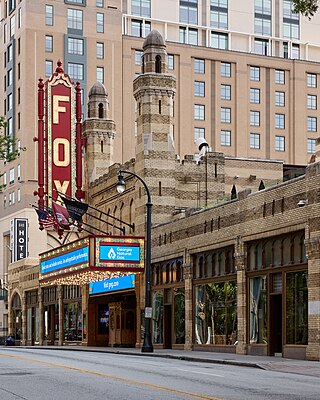
The Fox Theatre, a former movie palace, is a performing arts venue located at 660 Peachtree Street NE in Midtown Atlanta, Georgia, and is the centerpiece of the Fox Theatre Historic District.
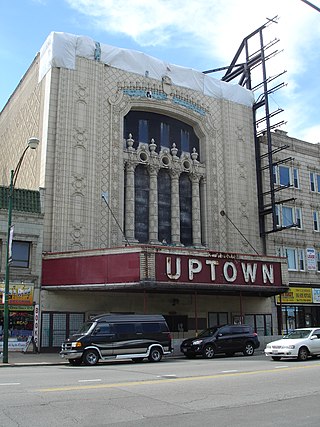
A movie palace is a large, elaborately decorated movie theater built from the 1910s to the 1940s. The late 1920s saw the peak of the movie palace, with hundreds opening every year between 1925 and 1930. With the advent of television, movie attendance dropped, while the rising popularity of large multiplex chains in the 1980s and 1990s signaled the obsolescence of single-screen theaters. Many movie palaces were razed or converted into multiple-screen venues or performing arts centers, though some have undergone restoration and reopened to the public as historic buildings.
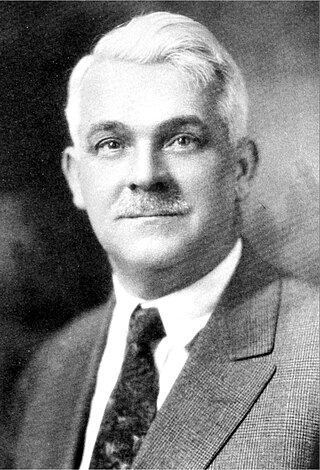
Thomas White Lamb was a Scottish-born, American architect. He was one of the foremost designers of theaters and cinemas of the 20th century.

The Kings Theatre, formerly Loew's Kings Theatre, is a live performance venue in the Flatbush neighborhood of Brooklyn, New York City. Opened by Loew's Theatres as a movie palace in 1929 and closed in 1977, the theater sat empty for decades until a complete renovation was initiated in 2010. The theater reopened to the public on January 23, 2015 as a performing arts venue. It was listed on the National Register of Historic Places on August 22, 2012.
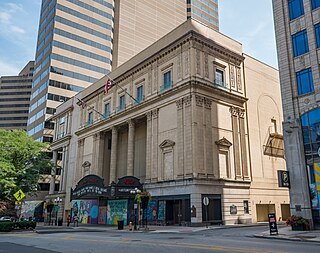
The Ohio Theatre is a performing arts center and former movie palace on Capitol Square in Downtown Columbus, Ohio. Known as the "Official Theatre of the State of Ohio", the 1928 building was saved from demolition in 1969 and was later completely restored. The theater was declared a National Historic Landmark in 1977.

The Loew's Jersey Theatre is a theater in Jersey City, New Jersey. Opened in 1929, it was one of the five Loew's Wonder Theatres, a series of flagship Loew's movie palaces in the New York City area. It was designed by the architectural firm of Rapp and Rapp in a Baroque/Rococo style. Tri-plexed in 1974, and then closed in 1986, it was dark for years. It was purchased by the city in 1993 and has been operated by a volunteer organization, the Friends of the Loews, since that time. The theater was designated as a New Jersey Registered Historic Site in 2009. In a move opposed by Friends of the Loews, the city in June 2014, agreed to let AEG Live operate the venue. After going to court, the lease by Friends of the Loews remains in effect. In 2022, a $72 million restoration project was started by Devils Arena Entertainment, a division of Harris Blitzer Sports & Entertainment that operates the Prudential Center, with completion being expected by 2025.

Warnors Theatre is a historic theater located in downtown Fresno, California. The 2,100-seat venue opened in 1928 as the Pantages Theater, after the name of its then owner, Alexander Pantages, and later, the Warner Theater in 1929 after it was purchased by Warner Brothers. The name was changed again in the 1960s to "Warnors" to avoid trademark issues.

The Palace Theater is a movie theatre in downtown Hilo, Hawai'i in the United States of America. Built in 1925, the theater is one of the more prominent public buildings constructed in Hilo in the early 20th century. Architects Davis & Fishbourne designed the theater in the Beaux-Arts style. The two-story building has five bays on its front facade; a metal marquee divides the two stories. The three central bays feature broken pediments and decorative urns above the second-floor windows. A parapet with a balustrade runs along the top of the building. After the original theater closed, the Palace reopened in 1998 as an arthouse.

Saenger Theatre is an atmospheric theatre in downtown New Orleans, Louisiana, which is on the National Register of Historic Places. Once the flagship of Julian and Abe Saenger's theatre empire, today it is one of only a handful of Saenger movie palaces that remain.

John Adolph Emil Eberson was an Austrian-American architect best known for the development and promotion of movie palace designs in the atmospheric theatre style. He designed over 500 theatres in his lifetime, earning the nickname "Opera House John". His most notable surviving theatres in the United States include the Tampa Theatre (1926), Palace Theatre Marion (1928), Palace Theatre Louisville (1928), Majestic Theatre (1929), Akron Civic Theatre (1929), the Paramount Theatre (1929), the State Theater 1927, and the Lewis J. Warner Memorial Theater (1932) at Worcester Academy in Worcester, Massachusetts. Remaining international examples in the atmospheric style include both the Capitol Theatre (1928) and State Theatre (1929) in Sydney, Australia, The Forum and Le Grand Rex.
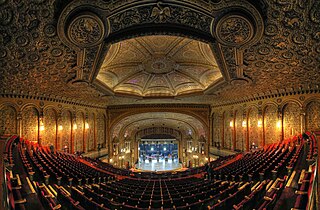
The United Palace is a theater at 4140 Broadway in the Washington Heights neighborhood of Manhattan in New York City. The theater, occupying a full city block bounded by Broadway, Wadsworth Avenue, and West 175th and 176th Streets, functions both as a spiritual center and as a nonprofit cultural and performing arts center. Architect Thomas W. Lamb designed the theater as a movie palace, which opened in 1930 as one of five Loew's Wonder Theatres in the New York City area. The theater's lavishly eclectic interior decor was supervised by Harold Rambusch, who also designed the interior of the Roxy Theatre and the Waldorf-Astoria Hotel.

An atmospheric theatre is a type of movie palace design which was popular in the late 1920s. Atmospheric theatres were designed and decorated to evoke the feeling of a particular time and place for patrons, through the use of projectors, architectural elements and ornamentation that evoked a sense of being outdoors. This was intended to make the patron a more active participant in the setting.

The Saenger Theatre is a historic theater and contributing building to the Lower Dauphin Street Historic District in Mobile, Alabama. It was dedicated in January 1927. The Saenger Theatre is a Mobile landmark, known for its architecture and ties to local cultural history. The theater has been completely renovated in recent years with an upgraded electrical system, VIP facilities, new stage rigging and sound system. It is the official home of the Mobile Symphony Orchestra and also serves as the venue for movie festivals, concerts, lectures and special events.

The Hamasa Shrine Temple Theater, added to the National Register of Historic Places in 1979, is a historic theater located at 2320 8th Street in Meridian, Mississippi. The Temple Theater was constructed in the Moorish Revival style and began screening silent films in 1928. The theater features a Byzantine motif, a swirl of marble fountains, and large bronze chandeliers. At the time of its construction, the theater contained one of the largest stages in the United States, second only to the Roxy Theater in New York City. The theater houses one of only two Robert Morton theatre organs still installed in their original locations in the State of Mississippi – the other being installed at the Saenger Theater in Hattiesburg, Mississippi. Both organs are under the care and restoration efforts of the Magnolia Chapter of the American Theatre Organ Society (ATOS).

The Balboa Theatre is an historic vaudeville/movie theatre in downtown San Diego, California, US, built in 1924. Listed on the National Register of Historic Places in 1996, the Balboa was refurbished and reopened as a performing arts venue in 2008.
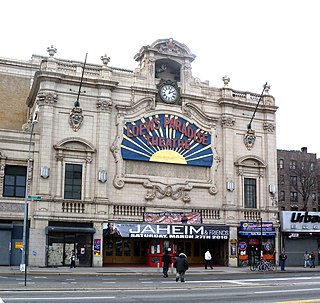
The Paradise Theater, formerly Loew's Paradise Theatre, is a movie palace-type theater located at 2417 Grand Concourse in the Bronx, New York. Constructed in 1929 at the height of grand movie theaters, in the later 20th century the building was used also for live entertainment. It was leased in 2012 for use by the World Changers Church International New York for founding a local congregation.

State Palace Theatre is a performing arts venue located in downtown New Orleans, Louisiana. It is located at the uptown lake corner of Canal Street and Rampart Street. The Saenger Theater is directly opposite the State Palace on Canal Street.
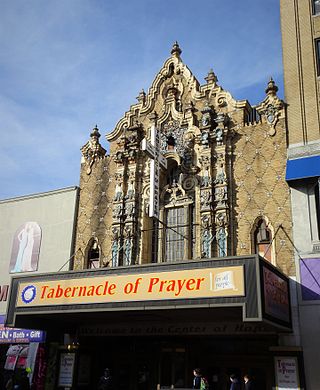
The Loew's Valencia Theatre is a former movie palace at 165-11 Jamaica Avenue in Queens, New York City. Built in 1929 as one of the Loew's Wonder Theatres, the theater was donated to The Tabernacle of Prayer for All People in 1977. It was designated an exterior landmark on May 25, 1999 by the New York City Landmarks Preservation Commission.
The Peninsula Theatre was a movie palace in Burlingame, California, that ran from 1926 to 1974. In 1957, the name was changed to Fox Burlingame. The theater was shuttered in 1974 and demolished in 1975 to make way for a shopping mall.






















